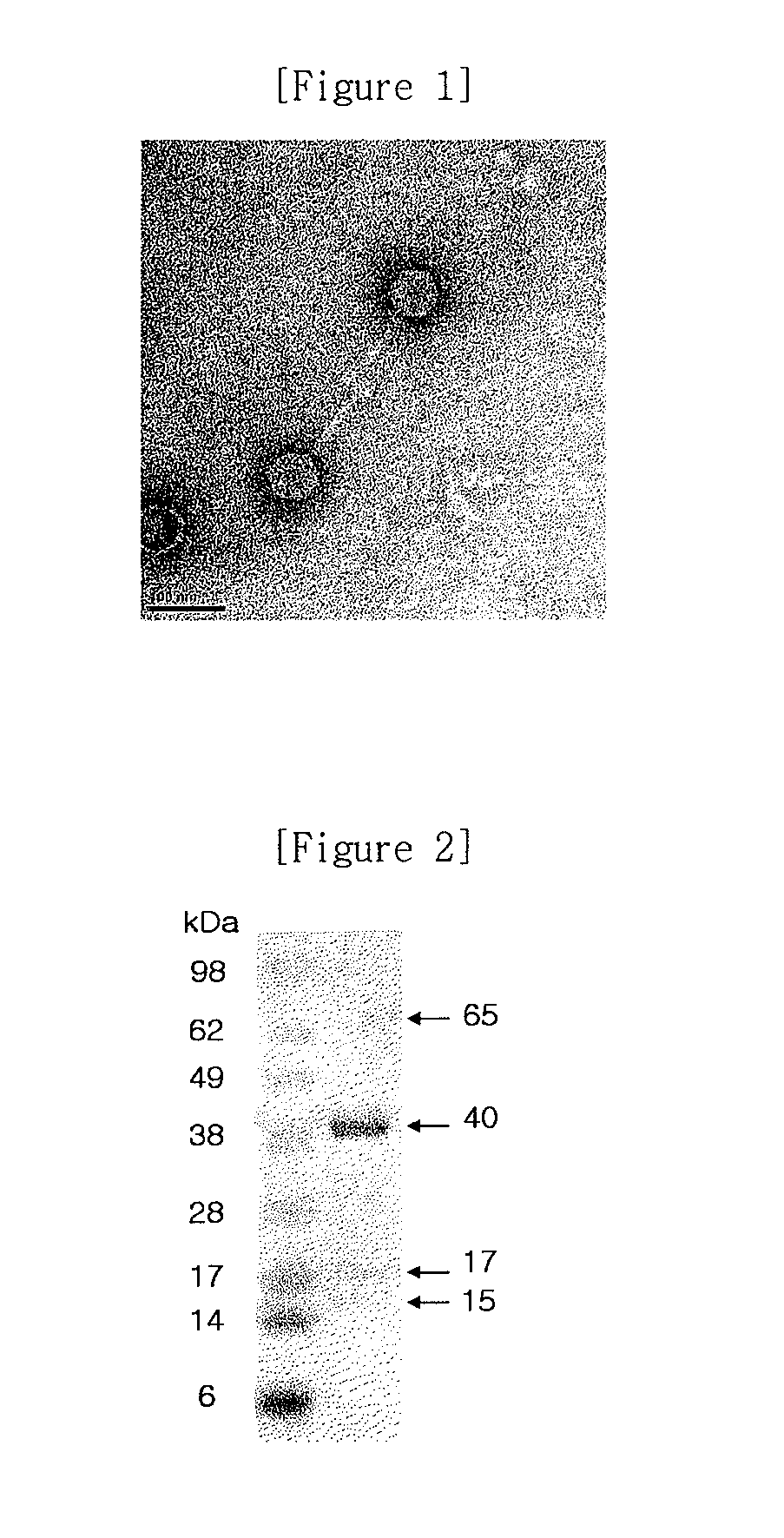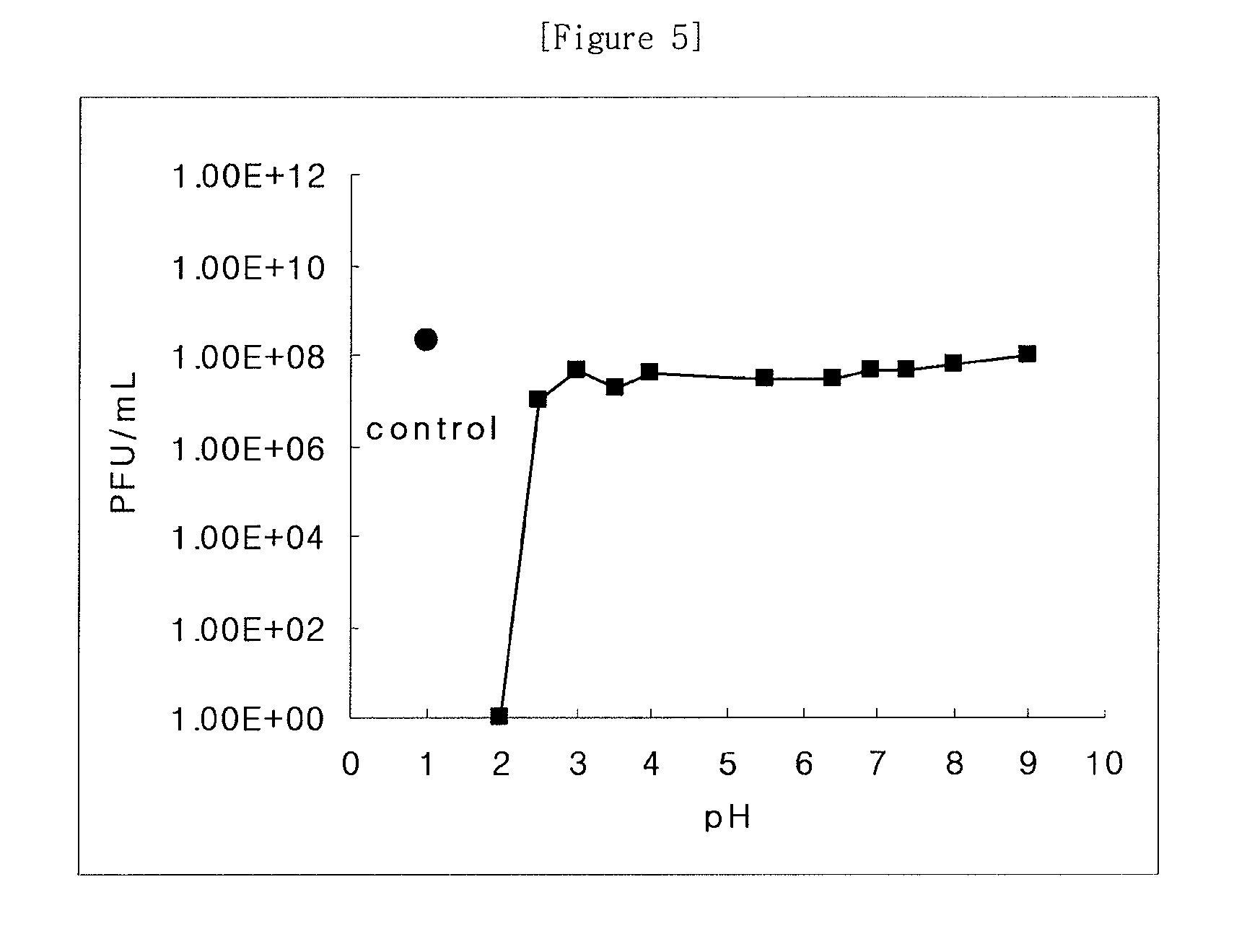Salmonella bacteriophage and antibacterial composition comprising the same
a bacteriophage and antibacterial technology, applied in the field of new bacteriophage, can solve the problems of increasing damage, serious economic losses of ft in brown, and increasing damage to farmers or consumers, and achieves specific bactericidal activity and excellent acid-, heat- and dry-resistance.
- Summary
- Abstract
- Description
- Claims
- Application Information
AI Technical Summary
Benefits of technology
Problems solved by technology
Method used
Image
Examples
example 1
Salmonella Bacteriophage Isolation
[0081]1-1. Bacteriophage Screening and Single Bacteriophage Isolation
[0082]50 ml of sample from chicken slaughterhouse and sewage effluent was transferred to a centrifuge tube, and centrifuged at 4000 rpm for 10 minutes. Then, the supernatant was filtered using a 0.45 μm filter. 18 ml of sample filtrate was mixed with 150 μl of ST shaking culture medium (OD600=2) and 2 ml of 10× Luria-Bertani medium (Hereinbelow, designated as LB medium, tryptone 10 g; yeast extract 5 g; NaCl 10 g; final volume to 1 L). The mixture was cultured at 37□ for 18 hours, and the culture medium was centrifuged at 4000 rpm for 10 minutes. The supernatant was filtered using a 0.2 μm filter. 3 ml of 0.7% agar (w / v) and 150 μl of ST shaking culture medium (OD600=2) were mixed, and plated onto LB plate, changed to a solid medium. 10 μl of culture filtrate was spread thereon, and cultured for 18 hours at 37□ (0.7% agar was used as “top-agar”, and the titration of phage lysate wa...
example 2
Examination on ΦCJ2 Infection of Salmonella
[0086]To examine the lytic activity of the selected bacteriophages on other Salmonella species as well as ST, cross-infection attempts with other Salmonella species were made. As a result, ΦCJ2 did not infect SE (Salmonella enterica Serotype Enteritis), SC (Salmonella enterica Serotype Choleraesuis), SD (Salmonella enterica Serotype Derby) and SA (Salmonella enterica subsp. Arizonae), SB (Salmonella enterica subsp. Bongori). When cross-infection attempts were made with Salmonella species other than ST ATCC14028 strain, the lytic activity was 40% or less, unlike SG and SP. This result suggests that ΦCJ2 is a bacteriophage specific to SG and SP (see Example 11). The results are shown in the following Table 1. The bacteriophages ΦCJ2 that was produced using SG as a host cell showed the same plaque size and plaque turbidity, and the same protein patterns and genome size as those produced using ST as a host cell.
[0087]
TABLE 1Salmonella>SeroPlaq...
example 3
Morphology Examination of Bacteriophage ΦCJ2
[0088]The purified ΦCJ2 was diluted in 0.01% gelatin solution, and then fixed in 2.5% glutaraldehyde solution. After the sample was dropped onto a carbon-coated mica plate (ca.2.5×2.5 mm) and adapted for 10 minutes, it was washed with sterile distilled water. Carbon film was mounted on a copper grid, and stained with 4% uranyl acetate for 30˜60 seconds, dried, and examined under JEM-1011 transmission electron microscope (80 kV, magnification of ×120,000˜×200,000). As a result, the purified ΦCJ2 was revealed to have morphological characteristics including an isometric capsid and a long non-contractile tail, as shown in 1>, indicating that it belongs to the morphotype of the family Siphoviridae.
PUM
| Property | Measurement | Unit |
|---|---|---|
| pH | aaaaa | aaaaa |
| pH | aaaaa | aaaaa |
| diameter | aaaaa | aaaaa |
Abstract
Description
Claims
Application Information
 Login to View More
Login to View More - R&D
- Intellectual Property
- Life Sciences
- Materials
- Tech Scout
- Unparalleled Data Quality
- Higher Quality Content
- 60% Fewer Hallucinations
Browse by: Latest US Patents, China's latest patents, Technical Efficacy Thesaurus, Application Domain, Technology Topic, Popular Technical Reports.
© 2025 PatSnap. All rights reserved.Legal|Privacy policy|Modern Slavery Act Transparency Statement|Sitemap|About US| Contact US: help@patsnap.com



